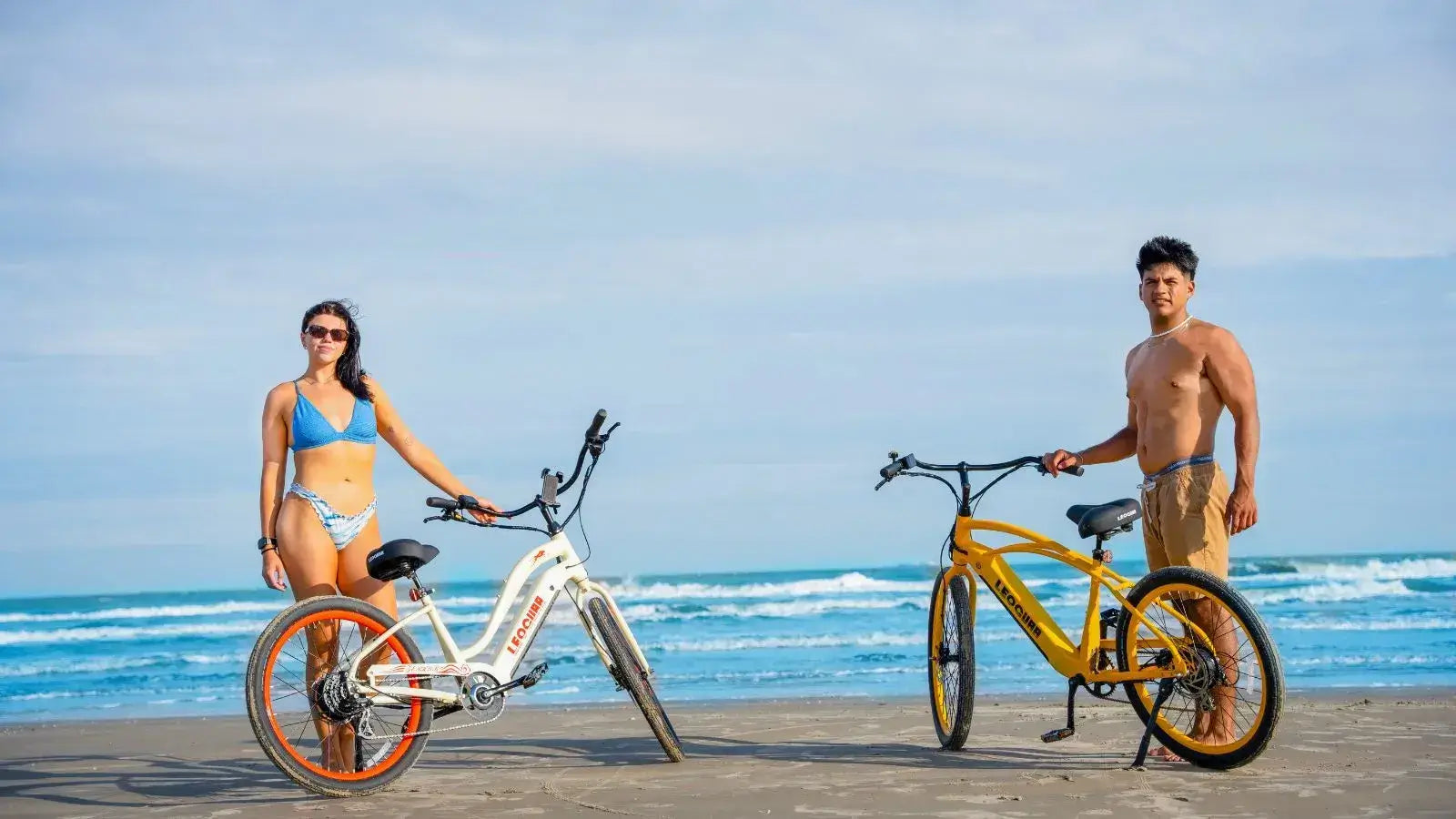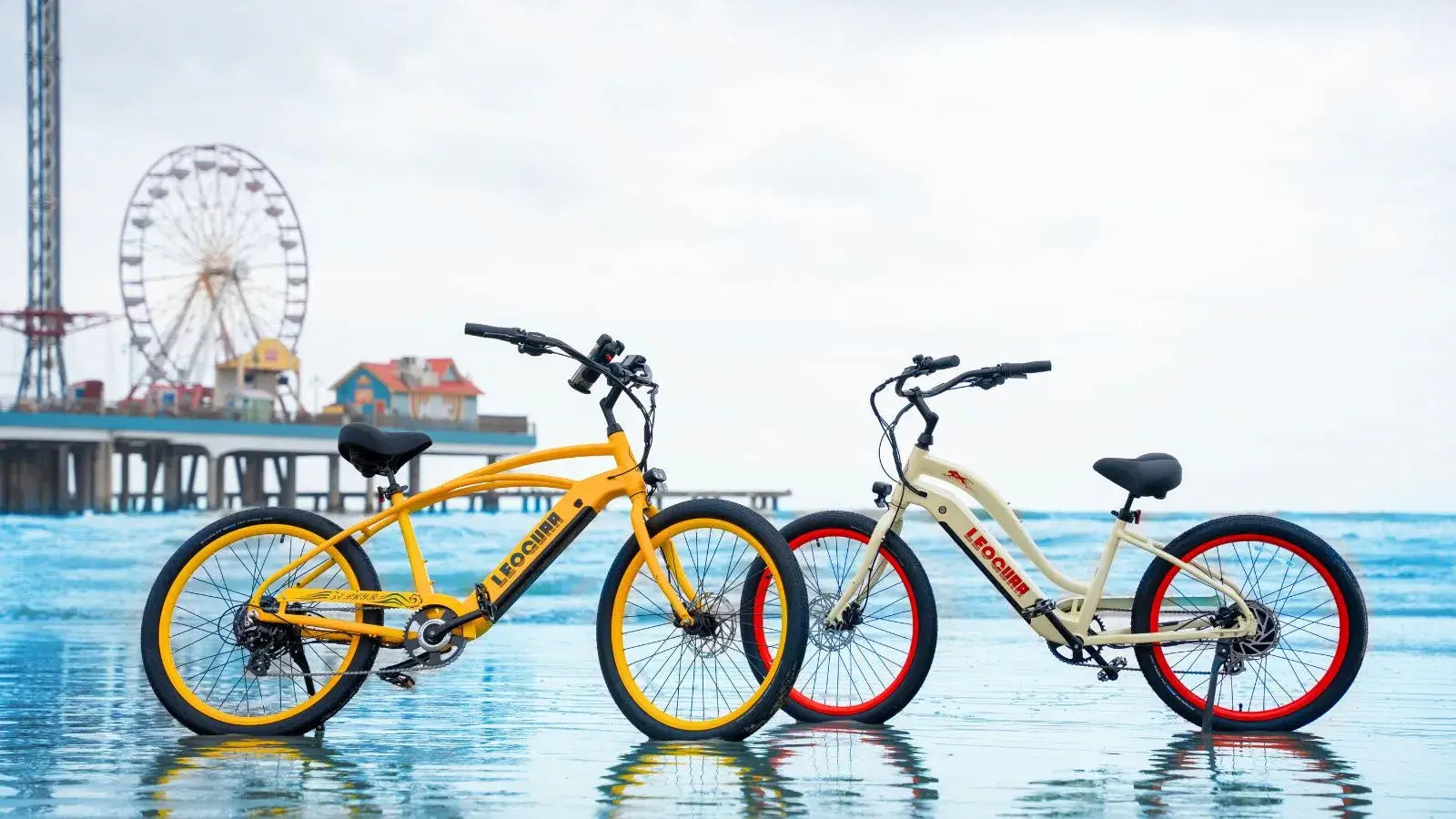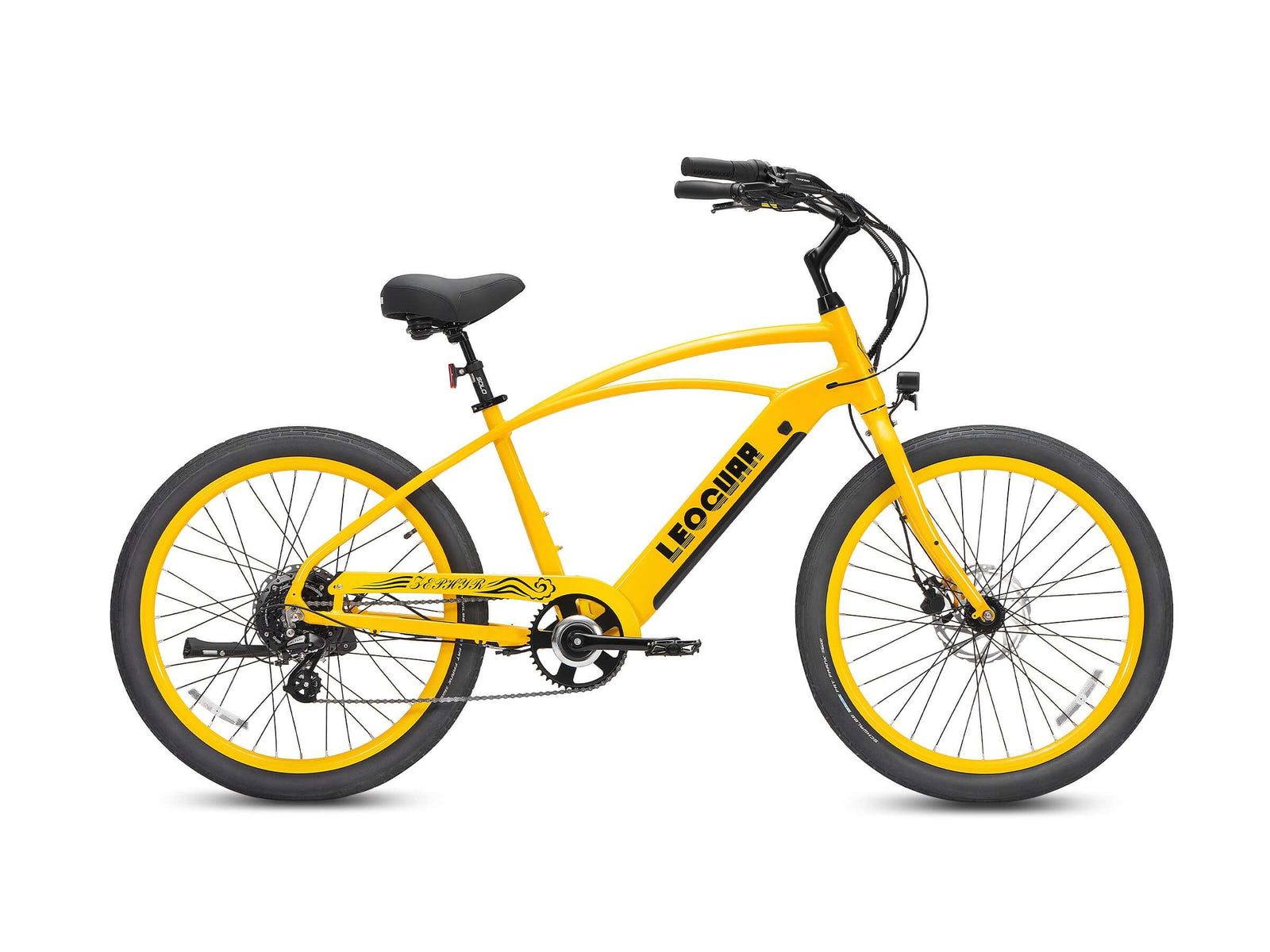
Can You Ride Electric Bikes on the Beach? How to Pick the Right E-Bike for Sand Riding
Quick Answer: Yes, you can ride an electric bike on the beach—but you need the right prep to do it safely and legally. Always check local rules to see if eBikes are allowed on your beach. Use a fat tire model or sand-ready eBike for better traction, and adjust your tire pressure if needed. After riding, rinse off salt and sand to protect your bike’s parts. Get these basics right, and you’ll enjoy smooth, fun beach rides without damage or fines.
You can't just roll your standard e-bike onto the nearest patch of sand and expect everything to work perfectly.
Success depends on three key factors: the local rules, the specific bike you're riding, and how you handle the ride and aftercare. Get these three things right, and you're in for an unforgettable adventure that will change how you think about beach exploration. Get them wrong, and you could face a fine, a damaged bike, or a very long walk home.
To make sure your beach ride succeeds, we'll break down everything you need to know. Think of this as your complete checklist for beach riding success.
- Local Laws: Are e-bikes even permitted on your chosen beach?
- The Right Bike: Is your e-bike ready to handle sand?
- Smart Riding & Maintenance: Do you know how to ride on sand and protect your bike from salt and grit?
Is It Legal to Ride an Electric Bike on the Beach?
Before you think about tire pressure, you need to answer the most important question: are you legally allowed to be there? There is no single, nationwide rule for e-bikes on beaches in the United States. Beach laws differ by state — for instance, can you ride ebikes on the beach in Florida depends on local beach access rules and county ordinances. Regulations are highly localized and can vary dramatically from one town to the next — for example, if you’re wondering can you ride electric bikes on the beach in Myrtle Beach, always check local signage and seasonal rules before heading out. What's perfectly acceptable on one beach might be strictly forbidden just down the coast.
Local authorities often categorize e-bikes into three classes. These classifications determine where you can and cannot ride your electric bike.
- Class 1: Pedal-assist only, with a motor that stops assisting at 20 mph.
- Class 2: Throttle-on-demand, with a motor that stops assisting at 20 mph.
- Class 3: Pedal-assist only, with a motor that stops assisting at 28 mph.
Some laws treat Class 1 and 2 e-bikes like traditional bicycles, while others classify all e-bikes as motorized vehicles. This means they ban them from pedestrian areas and beaches entirely. The variation is huge across different regions. For example, some progressive regions have embraced e-bike access completely. Some areas like the Oregon coast now officially permit e-bikes on the hard-packed, wet sand portions of nearly all their beaches. In stark contrast, due to safety concerns and congestion issues, cities like Laguna Beach have enacted specific rules that heavily restrict e-bike use on boardwalks and certain beach access points.
Check Local Rules Before Riding Electric Bikes on the Beach
Don't guess about the rules. Fines can be steep, and it's not worth the risk of getting in trouble with local authorities. Here's a simple checklist to find the rules for your specific beach location.
- Check Official Websites: Start with the official city or county Parks and Recreation department website. Look for sections on park rules, vehicle access, or bicycle regulations that might mention e-bikes specifically.
- Look for Posted Signs: When you arrive at the beach or a private community like Sea Pines, carefully read any signs to confirm can you ride electric bikes in Sea Pines, as private paths often have unique restrictions. They will often list prohibited activities and vehicles, including different types of bikes.
- Call and Ask: If the online information is unclear, don't hesitate to call the local non-emergency police line or a park ranger's office. A local bike shop that offers rentals is also an excellent source of on-the-ground information about current rules.
Best Electric Bike Features for Riding on the Beach
Riding on sand is demanding — so you need the right electric bike features to handle soft surfaces, salt, and wind.
Once you've confirmed it's legal, the focus shifts to your equipment. Riding on sand puts unique and intense stress on a bike that most standard e-bikes simply cannot handle effectively. The right features are not just helpful; they are essential for a good experience that won't leave you stranded.
Why Fat Tires Matter for Sand
If you want to ride on sand, you want a fat tire e-bike. There's no substitute for the performance that fat tires provide in sandy conditions. Fat tires, which are typically 4 inches wide or more, are the gold standard for one simple reason: flotation on soft surfaces. A narrow tire will slice into the sand and dig itself into a rut, bringing you to a grinding halt almost immediately.
A wide, fat tire distributes your weight over a much larger surface area, allowing it to "float" on top of the sand. This works much like a snowshoe works on snow, spreading the load to prevent sinking. To maximize this effect, you'll need to run very low tire pressure (PSI) compared to normal riding conditions.
While you might run 50-70 PSI on a road bike, on sand, you'll be down in the 5-15 PSI range. This allows the tire to flatten out, creating the largest possible contact patch for traction and float. Finding the right tire pressure is a balance, but for sand, lower is almost always better than higher pressure.
Motor Power and Placement
Sand creates immense drag, far more than pavement or even dirt trails. Your e-bike's motor will be working hard to keep you moving forward through the resistance. We recommend a motor with a nominal wattage of at least 500W for basic beach riding. For tackling softer, deeper sand or steeper beach inclines, a 750W motor (or even 1000W) is ideal for consistent performance.
It's not about speed; it's about having the torque to overcome the resistance without overheating or stalling. You'll find two main types of motors on fat bikes: rear hub and mid-drive systems.
- Rear Hub Motors: These are located in the center of the rear wheel. They are powerful, reliable, and very common on fat tire e-bikes designed for challenging terrain.
- Mid-Drive Motors: These are located at the crankset. They often provide a more balanced feel and can leverage the bike's gears for superior efficiency and climbing ability, though they can put more strain on the chain.
Both can work exceptionally well, but a powerful motor of either type is non-negotiable for sand riding.
Other Must-Have Beach Features
- Corrosion Resistance: Saltwater and salty air are extremely corrosive to metal components. A bike built for the beach should have an aluminum frame, stainless steel or specially coated chains and hardware, and sealed bearings in the hubs.
- Battery Capacity: Riding on sand drains your battery fast—expect to use 50-100% more power than you would on pavement. A small battery won't get you very far on a beach adventure.
- Simple Drivetrain: The beach is not the place for a complex, sensitive 27-speed drivetrain. Sand can easily jam derailleurs and clog up cassette cogs, making shifting difficult or impossible.
Rider’s Guide: How to Ride an Electric Bike on Sand
If you wonder can you ride electric bikes on the beach safely, mastering how to ride on sand makes all the difference. Riding on the beach isn't a single experience; the sand itself dictates the ride. We've spent countless hours on different coastlines, and the key to success is adapting your technique to the specific conditions under your tires. The same beach can offer two completely different riding experiences just 50 feet apart, depending on sand conditions.
Mastering the Terrain
The primary distinction is between the hard-packed sand near the water and the soft, dry sand higher up the beach. Understanding how to approach each type is crucial for a successful ride.
| Feature | Hard-Packed Wet Sand | Soft, Dry Sand |
|---|---|---|
| Location | Near the low-tide waterline | Higher up the beach, near dunes |
| Best Tire Pressure | Higher (e.g., 12-20 PSI) | Lower (e.g., 5-10 PSI) |
| Riding Technique | Smoother, faster, more like a dirt road. Easier to turn. | Requires constant momentum and minimal steering input. |
| Motor Assist | Lower assist levels (1-3) are often sufficient. | Higher assist levels (3-5) or throttle needed to power through. |
| Feel | Stable and supportive. You can cruise with confidence. | Unstable and "squirmy." The bike will want to wander. |
Essential Riding Techniques
Beyond adjusting for the sand type, certain techniques apply to all beach riding. These skills will make the difference between a fun adventure and a frustrating struggle.
- Maintain Momentum: Momentum is your best friend on sand. It's much easier to keep moving than it is to get started from a dead stop, especially in soft sand conditions.
- Stay Seated: Standing up puts more weight on the rear wheel, which can cause it to dig in. Stay seated to keep your weight evenly distributed between both wheels for better flotation.
- Steer with Your Body, Not the Bars: Making sharp turns with the handlebars will cause the front wheel to plow into the sand and stop you cold. Use gentle, wide arcs and lean your body in the direction you want to go, keeping handlebar movements minimal.
- Use the Motor Wisely: Don't just rely on the throttle for power. Use a combination of pedal assist and steady pedaling to maintain a smooth application of power through challenging sections.
- Look Ahead: Don't stare at your front wheel. Look 15-20 feet ahead to pick your line and scan for the smoothest, firmest-looking path while avoiding patches of deep sand.
| Sand Type | Recommended Tire Pressure | Why |
|---|---|---|
| Hard-Packed Wet Sand | 12–15 PSI | Better support & speed |
| Soft Dry Sand | 5–10 PSI | Max flotation to stay on top |

The Aftermath: Post-Ride Care for Electric Bikes on the Beach
You had a fantastic ride along the shoreline. Now comes the most important part for your bike's longevity: the cleanup process. Salt and sand are a fatal combination for metal components that can destroy your investment if ignored. Salt accelerates rust and corrosion at an alarming rate, while sand acts like liquid sandpaper, grinding away at your drivetrain and bearings.
Neglecting post-ride maintenance is the fastest way to ruin a perfectly good e-bike. We live by the 30-Minute Rule: always rinse and clean your beach ebike within 30 minutes of finishing your beach ride. Don't let it sit overnight with salt and sand on the components.
Your Post-Ride Checklist
Follow this process every single time you ride on the beach. It might seem tedious, but it will save you hundreds or even thousands of dollars in repairs and component replacement.
| Step | What to Do | Why It's Critical |
|---|---|---|
| 1. Gentle Rinse | Use a low-pressure hose (never a pressure washer) to gently rinse the entire bike. Start from the top and work your way down. | This removes the loose sand and surface salt before you start scrubbing, preventing you from grinding the grit into the paint and components. |
| 2. Wash | Use a bucket of soapy water (bike-specific wash or mild dish soap) and a soft brush or sponge. Gently scrub the frame, wheels, and especially the drivetrain (chain, cassette, derailleurs). | This removes the sticky, corrosive salt film that rinsing alone can't get. It's essential for protecting bearings and metal surfaces. |
| 3. Final Rinse | Give the bike another gentle, thorough rinse with fresh water to remove all the soap residue. | Soap residue can attract dirt and grime. A clean rinse leaves the bike spotless. |
| 4. Dry | Use an old towel or a leaf blower to dry the bike completely. Pay special attention to the chain, cassette, and any bolts or moving parts. | Water causes rust. Drying the drivetrain immediately is crucial before applying new lubricant. |
| 5. Lube | Once the chain is bone dry, apply a high-quality chain lubricant (a "wet" or "all-weather" lube is often best after beach exposure). Apply one drop to each link's roller, let it sit for a few minutes, then wipe off all the excess with a clean rag. | This protects the chain from rust and ensures smooth shifting on your next ride. An un-lubed chain will rust almost instantly after being exposed to salt. |
What Not to Do
- Never use a high-pressure washer on your e-bike. It will force water and sand past the seals and into your motor, bearings, and electrical connections, causing catastrophic damage.
- Never spray water directly at the motor, battery contacts, or display unit. Use a damp cloth to wipe these areas down gently instead.
- Never put your bike away wet or sandy. This is a death sentence for your components and will lead to expensive repairs.
How to Clean an Electric Bike After Riding on the Beach
Riding on the beach is fun, but salt, sand, and moisture can ruin your electric bike fast if you don’t clean it properly. Here’s a quick step-by-step routine to protect your e-bike from rust and corrosion:
Step 1: Power off and remove the battery.
Step 2: Rinse the bike gently with fresh water — avoid high-pressure sprays that might force water into bearings and electronics.
Step 3: Use a soft brush or sponge with mild soapy water to scrub the frame, wheels, chain, and gears.
Step 4: Rinse off soap and wipe down the bike with a clean cloth.
Step 5: Dry the bike completely, paying extra attention to the drivetrain and bolts.
Step 6: Lubricate the chain and moving parts with bike-specific oil to prevent rust.
A few minutes of careful cleaning after every beach ride can add years of life to your electric bike.
Should You Ride an Electric Bike on the Beach?
So, can you ride an electric bike on the beach? The answer is a resounding yes, and it's an experience we highly recommend. It's a uniquely freeing and exhilarating experience that we believe every e-bike enthusiast should try at least once in their riding journey.
But it's an adventure that demands respect and preparation. Success hinges on a simple formula: the Right Rules, the Right Bike, the Right Technique, and the Right Care. By ensuring your ride is legal, choosing a capable fat tire e-bike, mastering the art of riding on sand, and committing to meticulous post-ride cleaning, you're not just going for a bike ride.
You're unlocking a whole new coastal playground for your e-bike adventures. The combination of ocean views, fresh sea air, and the unique challenge of sand riding creates memories that last a lifetime.
Frequently Asked Questions
1. Q: What type of e-bike is best for beach riding?
A: A fat tire e-bike with tires 4 inches wide or more is essential for beach riding. The bike should have at least a 500W motor, preferably 750W or higher, and features like corrosion-resistant components and sealed bearings to handle the harsh beach environment.
2. Q: How much should I lower my tire pressure for sand riding?
A: For sand riding, you should run much lower tire pressure than normal - typically between 5-15 PSI. Hard-packed wet sand can handle slightly higher pressure (12-20 PSI), while soft dry sand requires the lowest pressure (5-10 PSI) for maximum flotation.
3. Q: Do I need to clean my e-bike after every beach ride?
A: Yes, absolutely. You must rinse and clean your e-bike within 30 minutes of finishing any beach ride. Salt and sand are extremely corrosive and abrasive, and leaving them on your bike overnight can cause serious damage to metal components and the drivetrain.
4. Q: Are e-bikes allowed on all beaches?
A: No, e-bike regulations vary dramatically by location. There is no nationwide rule, and laws can change from one town to the next. Always check with local Parks and Recreation departments, look for posted signs, or call local authorities before riding on any beach.
5. Q: How much more battery power does beach riding use?
A: Beach riding typically uses 50-100% more battery power than riding on pavement due to the increased resistance from sand. Make sure you have a high-capacity battery (at least 600Wh, preferably 700Wh or more) and plan shorter rides than you would on normal terrain.
6. Q: Can you ride an electric bike on the road and the beach?
A: Yes — most electric bikes are fully legal for road use, provided they meet local e-bike class regulations. However, riding on the beach often needs extra preparation, like fat tires, lower tire pressure, and corrosion-resistant parts.
7. Q: Can electric bikes go on sand?
A: Yes, but only if they’re designed for it. A beach-ready e-bike with fat tires, lower tire pressure, and rust-resistant parts handles loose sand far better than standard commuter models.
Our beach riding guides are written with insights from experienced e-bike riders who test different models on real sand and coastal conditions, helping you trust every ride and upgrade confidently.









































Leave a comment